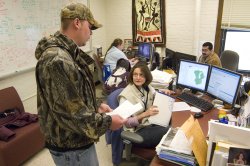Human-Environment Modeling and Analysis Lab (HEMA)

The FNR Human-Environment Modeling and Analysis (HEMA) Laboratory is devoted to the study of the causes and consequences of land use/cover change. Grounded in the theoretical framework of complex socio-ecological systems, research in the HEMA lab employs advanced technologies and methodologies from a wide array of disciplines. Research focuses on the development of spatially explicit models The HEMA lab is composed of (a) two large computational labs, (b) a high tech conference room and (c) a computer room with a High Performance Compute Cluster (HPCC). The computational lab houses student workspaces each containing a high-end workstation with dual flat panel monitors. The HPCC is composed of nine low (2GB) computational nodes and one high (8GB RAM) node. Two Dell PowerVault 221S SCSI raid disk storage systems (with 5.2 TB of storage) serves as the centralize storage facility for the lab. A Dell PowerVault Autoloader Tape Backup Library (LTO-2) that stores and retrieves up to twenty-four 432 GB tapes (for a total of 9.1 TB) is used for long-term backup. The ten dual Xeon (3.8 GHz) rack mounted workstations are used to support modeling and analysis and twenty-four 1 Gb/s CAT6 network lines provide high speed data transfer. A VPN server and Linux firewall secure the laboratory. The conference room has a PolyVision electronic white board, a conference table for meetings accommodating up to eight people. Also available is a Polycom VSX 5000 videoconferencing unit and a 30in Dell LCD panel. Software in the lab includes: ArcGIS 9.2 and all ESRI extensions including Spatial Analyst and Statistical Analyst, Erdas IMAGINE 8.X, ENVI and IDL, IDRISI (Andes Version), SAS 9.1, SPSS 14.0, MathCAD, Netica (Bayesian Software), Oracle, 3DMiner, S-Plus, R, Microsoft Visual Studio Professional and SNSS. that can be used to forecast and backcast land use/cover change in many regions of the world. Another interest of the lab is the development of acoustic sensors and sensor networks that can be used to understand the impacts that humans have on animal behavior and species richness.
 The HEMA lab is composed of (a) two large computational labs, (b) a high tech conference room and (c) a computer room with a High Performance Compute Cluster (HPCC). The computational lab houses student workspaces each containing a high-end workstation with dual flat panel monitors. The HPCC is composed of nine low (2GB) computational nodes and one high (8GB RAM) node. Two Dell PowerVault 221S SCSI raid disk storage systems (with 5.2 TB of storage) serves as the centralize storage facility for the lab. A Dell PowerVault Autoloader Tape Backup Library (LTO-2) that stores and retrieves up to twenty-four 432 GB tapes (for a total of 9.1 TB) is used for long-term backup. The ten dual Xeon (3.8 GHz) rack mounted workstations are used to support modeling and analysis and twenty-four 1 Gb/s CAT6 network lines provide high speed data transfer. A VPN server and Linux firewall secure the laboratory. The conference room has a PolyVision electronic white board, a conference table for meetings accommodating up to eight people. Also available is a Polycom VSX 5000 videoconferencing unit and a 30in Dell LCD panel. Software in the lab includes: ArcGIS 9.2 and all ESRI extensions including Spatial Analyst and Statistical Analyst, Erdas IMAGINE 8.X, ENVI and IDL, IDRISI (Andes Version), SAS 9.1, SPSS 14.0, MathCAD, Netica (Bayesian Software), Oracle, 3DMiner, S-Plus, R, Microsoft Visual Studio Professional and SNSS.
The HEMA lab is composed of (a) two large computational labs, (b) a high tech conference room and (c) a computer room with a High Performance Compute Cluster (HPCC). The computational lab houses student workspaces each containing a high-end workstation with dual flat panel monitors. The HPCC is composed of nine low (2GB) computational nodes and one high (8GB RAM) node. Two Dell PowerVault 221S SCSI raid disk storage systems (with 5.2 TB of storage) serves as the centralize storage facility for the lab. A Dell PowerVault Autoloader Tape Backup Library (LTO-2) that stores and retrieves up to twenty-four 432 GB tapes (for a total of 9.1 TB) is used for long-term backup. The ten dual Xeon (3.8 GHz) rack mounted workstations are used to support modeling and analysis and twenty-four 1 Gb/s CAT6 network lines provide high speed data transfer. A VPN server and Linux firewall secure the laboratory. The conference room has a PolyVision electronic white board, a conference table for meetings accommodating up to eight people. Also available is a Polycom VSX 5000 videoconferencing unit and a 30in Dell LCD panel. Software in the lab includes: ArcGIS 9.2 and all ESRI extensions including Spatial Analyst and Statistical Analyst, Erdas IMAGINE 8.X, ENVI and IDL, IDRISI (Andes Version), SAS 9.1, SPSS 14.0, MathCAD, Netica (Bayesian Software), Oracle, 3DMiner, S-Plus, R, Microsoft Visual Studio Professional and SNSS.
Acoustic equipment includes Larson Davis 824 microphones, custom portable data loggers capable of remote, wireless communication that are connected to a variety of environmental sensors (e.g., air and soil temperature, wind speed, wind direction, precipitation).
Research faculty
Lab Manager & More About Our Research
Bryan C. Pijanowski
203 Forestry Building
Department of Forestry and Natural Resources
Purdue University
West Lafayette, Indiana 47907
Telephone: (765) 496-2215
Email: bpijanow@purdue.edu
Learn about our nine Research Areas and meet our world-class faculty members.
Allied research centers seek to support and enhance the research and partnership enterprise at Purdue University. The centers are valued and encouraged as they create a venue for faculty to come together to pursue common goals. Forestry and Natural Resources faculty and staff are involved in six centers at the University.
The Department of Forestry and Natural Resources maintains an impressive collection of state-of-the-art research and education facilities. These labs, green houses, and educational facilities are a fundamental component that enables our faculty and students to learn, make new discoveries, and engage our clients in using these discoveries to sustain our nation’s ecosystems and natural resources.
